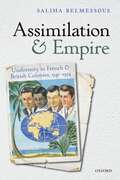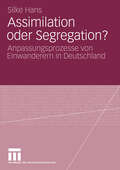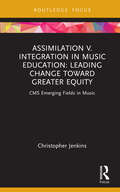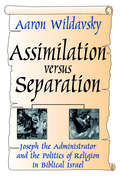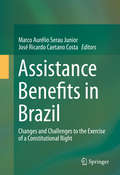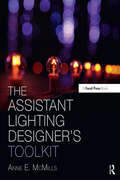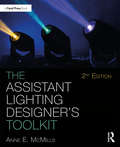- Table View
- List View
Assignments as Controversies: Digital Literacy and Writing in Classroom Practice (Routledge Research in Literacy)
by Ibrar BhattApproaching academic assignments as practical controversies, this book offers a novel approach to the study of digital literacy. Through in-depth accounts of assignment writing in college classrooms, Bhatt examines ways of understanding how students engage with digital media in curricular activities and how these give rise to new practices of information management and knowledge creation. He further considers what these new practices portend for a stronger theory of digital literacy in an age of informational abundance and ubiquitous connectivity. Looking also at how institutional digital learning policies and strategies are applied in classrooms, and how students may embrace or avoid imposed technologies, this book offers an in-depth study of learner practices. It is through the comprehensive study of such practices that we can better understand the efficacy of technological investments in education, and the dynamic nature of digital literacy on the part of students charged with using those technologies.
Assimilation And Empire: Uniformity In French And British Colonies, 1541-1954
by Saliha BelmessousAssimilation was an ideology central to European expansion and colonisation, an ideology which legitimised colonisation for centuries. Assimilation and Empire shows that the aspiration for assimilation was not only driven by materialistic reasons, but was also motivated by ideas. The engine of assimilation was found in the combination of two powerful ideas: the European philosophical conception of human perfectibility and the idea of the modern state. Europeans wanted to create, in their empires, political and cultural forms they valued and wanted to realise in their own societies, but which did not yet exist. Saliha Belmessous examines three imperial experiments - seventeenth- and eighteenth-century New France, nineteenth-century British Australia, and nineteenth and twentieth-century French Algeria - and reveals the complex inter-relationship between policies of assimilation, which were driven by a desire for perfection and universality, and the greatest challenge to those policies, discourses of race, which were based upon perceptions of difference. Neither colonised nor European peoples themselves were able to conform to the ideals given as the object of assimilation. Yet, the deep links between assimilation and empire remained because at no point since the sixteenth century has the utopian project of perfection - articulated through the progressive theory of history - been placed seriously in question. The failure of assimilation pursued through empire, for both colonised and coloniser, reveals the futility of the historical pursuit of perfection.
The Assimilation and Integration of Pre- and Postwar Refugees in the Netherlands (Research Group for European Migration Problems #11)
by H. Verwey-Jonker P.O.M. BrackelSome years ago the N etherlands Research Committee for European Refugee Problems commissioned an investigation into the adjustment problems of foreigners who for various reasons have taken refuge in the Netherlands. This investigation is of great interest. In these times of rapid change we all have our problems of adjustment. How very much greater these problems must be for those who had to leave all they cherished behind them and start all over again in new and strange surroundings. I wholeheartedlyendorse the Committee's initiative in publish ing in this monograph the main results of the investigation. These results should be useful in the work of the organizations concerned with refugee welfare. But in wider circles, both in the Netherlands and abroad, this publication should also awaken interest in the refugee question in general and the situation of refugees in the Nether lands in particular. How necessary this interest still is has been shown once again by the recent events in Hungary, which brought untold misery to many thousands. These Hungarian refugees and countless others who before them fled can best be helped to adjust to the new patterns of life if all who in their daily lives come into contact with them approach them in the right way. But to be able to do that we must first realize the difficulties the refugees have to contend with. Therefore the study of this monograph should be of posi tive value to many people.
Assimilation in American Life: The Role of Race, Religion and National Origins
by Milton M. GordonThe first full-scale sociological survey of the assimilation of minorities in America, this classic work presents significant conclusions about the problems of prejudice and discrimination in America and offers positive suggestions for the achievement of a healthy balance among societal, subgroup, and individual needs.
The Assimilation Myth: A Study of Second Generation Polish Immigrants in Western Australia (Research Group for European Migration Problems #14)
by R. JohnstonThis book is a logical consequence of a book published in 1965 under the title Immigrants Assimilation - A Study of Polish People in Western Australia. In the original study, adult Polish immigrants were asked, amongst other things, about their attitudes to their children's assimilation to the culture of the Australian society. Needless to say, some parents were eager for their children to remain Polish, whilst others express ed a desire for them to become Australians. Naturally, it seem ed practical to investigate the children's attitudes to their own assimilation. The present study is therefore mainly concerned with these attitudes. Much has been written about second generation immigrants and a lot has been of a speculative nature, since nobody has yet gone into the homes of immigrants and asked them and their children about the way they feel regarding a culture which is new to them. The present study is unique in this sense because it fills a vital gap by studying assimilation of two generations of immigrants belonging to the same family. Second generation immigrants have occupied the attention of many writers in the sociological and psychological litera ture. Vital social phenomena such as delinquency, mental breakdowns, and marginality have been ascribed to the second generation immigrants on account of their status as midway people between two cultural milieus. Some of these phenome It is generally accepted that na are traced in the present study.
The Assimilation of German Expellees into the West German Polity and Society Since 1945: A Case Study of Eutin, Schleswig-Holstein (Studies of Social Life #18)
by B.G. Lattimore Jr.The expulsions of German nationals from former Reich territories east of the Oder-Neisse Rivers and of German minority communities from various Eastern European nations following the collapse of the Nazi regime in 1945 constitute one of the least appreciated consequences of the Second World War. Numbering some ten million people, this group formed nearly a fifth of the total population of the new West German state which emerged in 1949 and presented a grave threat to its early stability. The state (Land) which received the greatest number of these largely destitute expellees in proportion to its indigenous population was Schleswig Holstein: in the years between 1945 and 1948 its population doubled. This predominately agrarian area underwent severe strains in accommodating these newcomers, and its handling of the expellee problem provided a bench mark for the evaluation of the assimilation process throughout the Federal Republic. While the tracing of the assimilation of the expellees into the West German polity and society has been voluminously documented l at the national level, much less research into the process has been conducted at the state and local levels. The principal reason for this seems to lie in the belief that the process has been success fully completed at these lower levels and may be considered a 1 The classic treatment of the first decade and a half of the assimilation process from the national level is Eugen Lemberg and Friedrich Edding, eds.
The Assimilation of Immigrants in the U.S. Labor Market: Employment and Labor Force Turnover (Garland Studies in the History of American Labor)
by Michael E. HurstThis book analyzes the labor market adjustment processes of immigrants in the United States. Newly-arrived immigrants earn less, work fewer weeks, and have higher rates of unemployment than native-born workers. After a period of assimilation, these conditions later converge to, and often surpass, those of native-born workers. The adjustment process traditionally implies greater employment turnover.Newly-arrived immigrant men have lower employment and labor force participation rates than similar native-born American men. Yet differences in unemployment rates are less consistent, and are complicated by shorter periods of unemployment duration for immigrants. Contrary to expectations, recent immigrants are less likely to be unemployed, even after adjusting for a lower duration of unemployment. This is partly because movements in and out of the labor force are high. Lower employment for recent immigrants is best explained by lower labor force participation, while higher unemployment rates are best explained by high rates of labor force entry. All labor force outcomes for immigrants, whether higher or lower upon arrival, converge to native-born norms after a few years of residence.
The Assimilation of Immigrants in the U.S. Labor Market: Employment and Labor Force Turnover (Garland Studies in the History of American Labor)
by Michael E. HurstThis book analyzes the labor market adjustment processes of immigrants in the United States. Newly-arrived immigrants earn less, work fewer weeks, and have higher rates of unemployment than native-born workers. After a period of assimilation, these conditions later converge to, and often surpass, those of native-born workers. The adjustment process traditionally implies greater employment turnover.Newly-arrived immigrant men have lower employment and labor force participation rates than similar native-born American men. Yet differences in unemployment rates are less consistent, and are complicated by shorter periods of unemployment duration for immigrants. Contrary to expectations, recent immigrants are less likely to be unemployed, even after adjusting for a lower duration of unemployment. This is partly because movements in and out of the labor force are high. Lower employment for recent immigrants is best explained by lower labor force participation, while higher unemployment rates are best explained by high rates of labor force entry. All labor force outcomes for immigrants, whether higher or lower upon arrival, converge to native-born norms after a few years of residence.
Assimilation v. Integration in Music Education: Leading Change toward Greater Equity (CMS Emerging Fields in Music)
by Christopher JenkinsAssimilation v. Integration in Music Education engages with an existential question for American conservatories and orchestras: What does it mean to diversify Western classical music? Many institutions have focused solely on diversifying the demography of their participants, but without a deeper conversation about structural oppression in classical music, this approach continues to isolate and exclude students of color. Rooted in the author’s experience working with BIPOC (Black, Indigenous, and People of Color) students at a major American conservatory, this book articulates the issues facing minority students in conservatories and schools of music, going beyond recruitment to address the cultural issues that alienate students. The author argues that the issue of diversity should be approached through the lens of aesthetics, and that the performance and pedagogy of Western classical music must change if a more diverse membership is to thrive in this genre. Reflecting on the author’s experience through the lens of recent critical theory in music education, this volume presents the viewpoints of Black and Latinx music students in their own words. Addressing the impact of racialized aesthetics on the well-being of BIPOC music students, the author shows how students are alienated when attempting to assimilate into conservatory environments and envisions an alternative, integrative approach to conservatory education. Offering a deep dive into the psychological and cultural reasons for the racialization of Western classical music, and potential institutional solutions, this concise book is relevant to performers, students, and institutional leaders.
Assimilation v. Integration in Music Education: Leading Change toward Greater Equity (CMS Emerging Fields in Music)
by Christopher JenkinsAssimilation v. Integration in Music Education engages with an existential question for American conservatories and orchestras: What does it mean to diversify Western classical music? Many institutions have focused solely on diversifying the demography of their participants, but without a deeper conversation about structural oppression in classical music, this approach continues to isolate and exclude students of color. Rooted in the author’s experience working with BIPOC (Black, Indigenous, and People of Color) students at a major American conservatory, this book articulates the issues facing minority students in conservatories and schools of music, going beyond recruitment to address the cultural issues that alienate students. The author argues that the issue of diversity should be approached through the lens of aesthetics, and that the performance and pedagogy of Western classical music must change if a more diverse membership is to thrive in this genre. Reflecting on the author’s experience through the lens of recent critical theory in music education, this volume presents the viewpoints of Black and Latinx music students in their own words. Addressing the impact of racialized aesthetics on the well-being of BIPOC music students, the author shows how students are alienated when attempting to assimilate into conservatory environments and envisions an alternative, integrative approach to conservatory education. Offering a deep dive into the psychological and cultural reasons for the racialization of Western classical music, and potential institutional solutions, this concise book is relevant to performers, students, and institutional leaders.
Assimilation Versus Separation: Joseph the Administrator and the Politics of Religion in Biblical Israel
by Gertrud LenzerHow to behave in the diaspora has been a central problem for Jews over the ages. They have debated whether to assimilate by adopting local customs or whether to remain a God-centered people loyal to their temporal rulers but maintaining the peculiar customs that separated them from their host nations. The question not only of survival, but of the basis for survival, is also a central problem in the Joseph stories of the Book of Genesis. The work shows its readers the grand alternatives of Judaism, instilled in two larger-than-life figures, so its readers can reassess for themselves the road Judaism did not take, and understand why Joseph though admirable in many respects, is left out of the rest of the Bible. The question is answered through the stories about how Joseph, the son of Jacob, saved his people/family from famine by becoming a high-ranking administrator to Pharaoh. By analyzing his behavior to the people over whom he exercises power, Joseph lords it over his brothers, grieves his father, takes lands from Egyptian farmers, and engages in forced deportation. Wildavsky explains why Joseph-the-assimilator is replaced in the Book of Exodus by Moses-the-lawgiver. The book ends by demonstrating that Joseph and Moses are, and are undoubtedly meant to be exact opposites. As in his earlier book on The Nursing Father: Moses as a Political Leader, Wildavsky combines analysis of political and administrative leadership with both traditional and modern study of texts: thematic linkages via plot, grammar, dreams, poetry, and religious doctrine. Thus the chapter on "Joseph the Administrator" is preceded by a chapter on Joseph as The Dream Lord" and followed by an analysis and explanation of why Jacob's obscure blessings to his sons are more like curses. Always the emphasis is on the reciprocal influence of religion and politics, on rival answers to questions about how Hebrews should relate to each other and to outsiders. New, in paperback, the book will be of interest to biblical scholars and readers as well as those concerned with the interaction of religion and political life.
Assimilation Versus Separation: Joseph the Administrator and the Politics of Religion in Biblical Israel
by Aaron WíldavskyHow to behave in the diaspora has been a central problem for Jews over the ages. They have debated whether to assimilate by adopting local customs or whether to remain a God-centered people loyal to their temporal rulers but maintaining the peculiar customs that separated them from their host nations. The question not only of survival, but of the basis for survival, is also a central problem in the Joseph stories of the Book of Genesis. The work shows its readers the grand alternatives of Judaism, instilled in two larger-than-life figures, so its readers can reassess for themselves the road Judaism did not take, and understand why Joseph though admirable in many respects, is left out of the rest of the Bible. The question is answered through the stories about how Joseph, the son of Jacob, saved his people/family from famine by becoming a high-ranking administrator to Pharaoh. By analyzing his behavior to the people over whom he exercises power, Joseph lords it over his brothers, grieves his father, takes lands from Egyptian farmers, and engages in forced deportation. Wildavsky explains why Joseph-the-assimilator is replaced in the Book of Exodus by Moses-the-lawgiver. The book ends by demonstrating that Joseph and Moses are, and are undoubtedly meant to be exact opposites. As in his earlier book on The Nursing Father: Moses as a Political Leader, Wildavsky combines analysis of political and administrative leadership with both traditional and modern study of texts: thematic linkages via plot, grammar, dreams, poetry, and religious doctrine. Thus the chapter on "Joseph the Administrator" is preceded by a chapter on Joseph as The Dream Lord" and followed by an analysis and explanation of why Jacob's obscure blessings to his sons are more like curses. Always the emphasis is on the reciprocal influence of religion and politics, on rival answers to questions about how Hebrews should relate to each other and to outsiders. New, in paperback, the book will be of interest to biblical scholars and readers as well as those concerned with the interaction of religion and political life.
Assistance Benefits in Brazil: Changes and Challenges to the Exercise of a Constitutional Right
by Marco Aurélio Serau Junior José Ricardo Caetano CostaThis edited book focuses on the most controversial aspects of assistance benefits as mandated by the Brazilian Constitution of 1988 - and the challenges that have merged since the approval, in 1993, of the Federal Act 8.742, also known as Organic Law of Social Assistance. This collection of essays allows the reader to understand some important changes in social assistance policies in Brazil in recent years, having the General Theory of Social Security and the Human Rights as references. The tensions between economic principles and affirmative policies for the less advantaged parts of the society are also covered, showing how different interpretations of key concepts - like need, poverty or family - may have an important role on the exercise of fundamental rights.
The Assistant Lighting Designer's Toolkit (The Focal Press Toolkit Series)
by Anne E. McMillsWhat are the do’s and don’ts of being a good assistant lighting designer? What are focus tapes, and how do I use them? What is the best method for creating a magic sheet? What should be found in every assistant’s kit? How do I make that first important leap into this professional career? Answer these questions and many more with The Assistant Lighting Designer’s Toolkit. This definitive guide unlocks the insider-secrets used to succeed as a professional assistant lighting designer (ALD) – whether choosing assisting as a career or while transitioning to another. This book outlines, step-by-step, the challenges the ALD faces during every phase of production. Never before has a resource existed that views the design process through the eyes of the assistant. Intermingled among the nuts and bolts of the paperwork and essential procedures, top industry professionals reveal tips for personal survival in this challenging career – both domestically and abroad as well as in other careers in lighting. Within these pages are the industry secrets rarely taught in school! The author's website can be found at http://www.aldtoolkit.com/.
The Assistant Lighting Designer's Toolkit (The Focal Press Toolkit Series)
by Anne E. McMillsWhat are the do’s and don’ts of being a good assistant lighting designer? What are focus tapes, and how do I use them? What is the best method for creating a magic sheet? What should be found in every assistant’s kit? How do I make that first important leap into this professional career? Answer these questions and many more with The Assistant Lighting Designer’s Toolkit. This definitive guide unlocks the insider-secrets used to succeed as a professional assistant lighting designer (ALD) – whether choosing assisting as a career or while transitioning to another. This book outlines, step-by-step, the challenges the ALD faces during every phase of production. Never before has a resource existed that views the design process through the eyes of the assistant. Intermingled among the nuts and bolts of the paperwork and essential procedures, top industry professionals reveal tips for personal survival in this challenging career – both domestically and abroad as well as in other careers in lighting. Within these pages are the industry secrets rarely taught in school! The author's website can be found at http://www.aldtoolkit.com/.
The Assistant Lighting Designer's Toolkit (The Focal Press Toolkit Series)
by Anne E. McMillsThe ground-breaking text that took the lighting world by storm returns in its second edition, unlocking the insider secrets and proven, time-tested methods to succeed as a professional assistant lighting designer. This definitive guide outlines, step-by-step, the daily challenges that assistant lighting designers face during every phase of production, and the solutions for overcoming them. Furthermore, intermingled among the highly detailed paperwork techniques and essential procedures, top industry professionals reveal tips for success in this challenging career. This fully updated second edition features: All new advice, real-world stories, and current paperwork examples from over 120 working professionals. Updated industry practices with case studies from the professionals themselves, such as how to create a video network to record previews for the lighting department; how much printing is done in an increasingly paperless world; how to produce a set electrics package; and how the industry interfaces with cutting-edge technology like remote followspots and pre-visualization software. New lifestyle tips for traveling abroad, negotiating contracts, and dealing with stressful situations. The Assistant Lighting Designer's Toolkit, the most trusted authority on assisting in the lighting world, equips budding assistant lighting designers and students studying lighting design with the insider knowledge they need to achieve the successful career that they have always wanted—whether choosing assisting as a career or as a stepping-stone toward design. Within these pages are the industry secrets rarely taught in school!
The Assistant Lighting Designer's Toolkit (The Focal Press Toolkit Series)
by Anne E. McMillsThe ground-breaking text that took the lighting world by storm returns in its second edition, unlocking the insider secrets and proven, time-tested methods to succeed as a professional assistant lighting designer. This definitive guide outlines, step-by-step, the daily challenges that assistant lighting designers face during every phase of production, and the solutions for overcoming them. Furthermore, intermingled among the highly detailed paperwork techniques and essential procedures, top industry professionals reveal tips for success in this challenging career. This fully updated second edition features: All new advice, real-world stories, and current paperwork examples from over 120 working professionals. Updated industry practices with case studies from the professionals themselves, such as how to create a video network to record previews for the lighting department; how much printing is done in an increasingly paperless world; how to produce a set electrics package; and how the industry interfaces with cutting-edge technology like remote followspots and pre-visualization software. New lifestyle tips for traveling abroad, negotiating contracts, and dealing with stressful situations. The Assistant Lighting Designer's Toolkit, the most trusted authority on assisting in the lighting world, equips budding assistant lighting designers and students studying lighting design with the insider knowledge they need to achieve the successful career that they have always wanted—whether choosing assisting as a career or as a stepping-stone toward design. Within these pages are the industry secrets rarely taught in school!
The Assistant Principal's Guide: New Strategies for New Responsibilities
by M. Scott NortonThough traditionally responsible for school operations, assistant principals increasingly find themselves expected to provide academic leadership as students face a growing emphasis on academic performance. This timely book helps current and aspiring assistant principals implement best practices for their evolving roles, providing the knowledge and skills required to succeed in their schools. Coverage includes: Emphasis on competency-based leadership requirements Research-based models, tips, snapshots, best-practices, and recommendations Unique discussion of the assistant principal as a student advocate Organizational strategies, professional growth activities, and operational models for program implementation Specific leadership responsibilities for school climate, personnel administration, professional development, and performance appraisal Case studies and discussion questions to foster applied learning
The Assistant Principal's Guide: New Strategies for New Responsibilities
by M. Scott NortonThough traditionally responsible for school operations, assistant principals increasingly find themselves expected to provide academic leadership as students face a growing emphasis on academic performance. This timely book helps current and aspiring assistant principals implement best practices for their evolving roles, providing the knowledge and skills required to succeed in their schools. Coverage includes: Emphasis on competency-based leadership requirements Research-based models, tips, snapshots, best-practices, and recommendations Unique discussion of the assistant principal as a student advocate Organizational strategies, professional growth activities, and operational models for program implementation Specific leadership responsibilities for school climate, personnel administration, professional development, and performance appraisal Case studies and discussion questions to foster applied learning
Assisted Circulation
by Felix UngerJ. Navratil The performance of operations on the heart and its replacement by a trans planted or artificial heart has been an age old dream of man. Rehn for example in an early attempt, in 1868 performed a closure of a heart wound after a thoracic puncture. At that time noone thought that this attempt was the beginning of cardiac surgery. The dream was partially realized when the replacement of the heart function by the heart-lungmachine became possible. Immediately following the first operations, cardiac surgeons and cardiologists saw with great enthusiasm that this machine could be an important tool for correcting congenital and non congenital heart diseases. However, the heart-lungmachine was soon seen to not be an optimal instrument for controlling cardiac failure after cardiopulmonary bypass or myocardial infarction. then arose for the development of mechanical assistance to the heart. Concepts The rollerpump was first designed for assisted circulation and could be applied clinically in 1962. A new concept of mechanical assistance to the heart was pro vided by the intra aortic balloon pump and later by the bypass ventricles. Use of the intra aortic balloon pump can reduce cardiac work by counterpulsation in accord with the natural ECG. The bypass ventricle can functionally replace the heart in series or parallel to the natural heart. The intra aortic balloon pump, now an established method, has reduced the number of patients who used to die from cardiac failure.
Assisted Circulation 2
by Felix UngerIt is a great pleasure to have the opportunity to edit a new volume of "Assisted Circulation". In the past 5 years there have been many changes in the philosophy of assisted circulation. There have been a large number of clinical application- of left ventricular assist devices, biventricular assist devices, and total artificial hearts; one artificial heart was implanted electively in December, 1982, in a patient with an end-stage cardiomyopathy. A great deal of help is necessary in editing a book. I want especially to thank the Austrian Research Council and the University of Innsbruck for their support of my work. I am most grateful to my co-workers R. Schistek, I. Koller, J. Hager, and R. Nessler, and especially to my secretary, W. Kirchner, who had the most secretarial load ofthe editorial work. I would also like to thank Dr. J. Wieczorek, Mrs. M. Schafer, Mrs. M. Griindler, and the Springer staff who gave this second volume an attractive format and made it accurate as usual. It was with great sorrow that we learned of the sad death of Dr. Emery Nyilas in June 1984, who played a great part in the development of artificial hearts. I hope that this second volume will also raise new items for discussion, resulting in new concepts, so that the third volume can introduce new devices and report on more clinical applications.
Assisted Circulation 3
by Ali F. AbuRahmaAssisted Circulation 3 is an authoritative review of the progress which has been achieved in the last 5 years since the appearance of Assisted Circulation 2 in 1984. The present book highlights the work of well-known experts on - new indications for assisted circulation, - cardiac assist devices as bridges toward transplantation, - temporary mechanical heart support, - results of long term studies into problems of tissue overgrowth, infection, and physiological regulation of cardiac devices, and - new results on cardiac transplantation and the new immunsuppresive regima. Assisted Circulation 3 is the latest product of an ongoing effort by the editors to keep readers abreast of recent advances in the field on a regular basis.
Assisted Circulation 4
by Felix UngerAssisted Circulation 4 is an authoritative review of the progress which has been achieved in the last 5 years since the publication of Assisted Circulation 3 in 1989. The present book highlights the work of well-known experts on indications for assisted circulation, cardiac support devices such as bridges, devices for transplantation, devices for chronic mechanical support, biological energy sources, cardiomyoplasty, extracorporeal membraneoxygenation and an overview of cardiac devices support with a specific emphasis on xenotransplantation. Assisted Circulation 4 is the latest product of an ongoing effort by the editors to keep readers regularly informed of recent developments in the field. Assisted Circulation is a standard technology in cardiac surgery and especially in cardiac transplantation.


